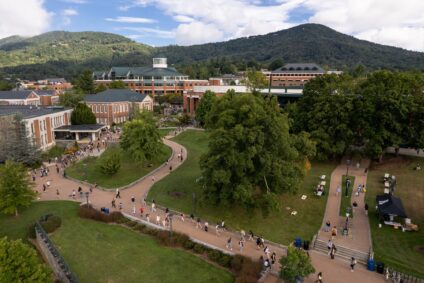Boone, Facebook, and Marcus Aurelius…Oh My
“There are two places you need to go often: The place that heals you. The place that inspires you.”
— Author Unknown
Not all memes are throwaway wisdom or empty platitudes. Some strike a chord. This one did. I came across it recently on Facebook, and I paused and thought, “Yes, that’s true for me.”
 When I think of “the place that heals me,” my mind goes to Boone, North Carolina. Tucked in the Blue Ridge Mountains, it’s where I went to college at Appalachian State University. I’ve returned there as often as I could since. Each visit brings a kind of gentle calm, like the mountains are exhaling just enough peace to quiet my thoughts. There’s something about coming around and down that last turn into Boone on 321, breathing in the mountain air, and walking those streets and the campus (less familiar these days) that reminds me who I am, or maybe who I once hoped to be.
When I think of “the place that heals me,” my mind goes to Boone, North Carolina. Tucked in the Blue Ridge Mountains, it’s where I went to college at Appalachian State University. I’ve returned there as often as I could since. Each visit brings a kind of gentle calm, like the mountains are exhaling just enough peace to quiet my thoughts. There’s something about coming around and down that last turn into Boone on 321, breathing in the mountain air, and walking those streets and the campus (less familiar these days) that reminds me who I am, or maybe who I once hoped to be.
And “the place that inspires”? That can vary. Sometimes it’s a beautiful sanctuary, literal or figurative. Sometimes it’s a conversation, a visit to the library, or an amazing orchestra concert. What matters is not the geography but the effect. It stirs something. Re-grounds me. Makes me want to live better.
So, yes, I understand this meme in my bones. But the more I thought about it, the more I began to wonder how it would sound to a Stoic like Marcus Aurelius or Seneca. Would they nod in agreement? Or tilt their heads, puzzled by the very idea?
The Stoic View of Where to Go
For the Stoics, the most crucial place to go often wasn’t a literal location at all. It was inward. “People look for retreats for themselves, in the country, by the sea, in the mountains,” Marcus writes in Meditations. “But this is altogether unphilosophic, when you can at any moment retreat into yourself.”
According to the Stoics, the internal retreat was where genuine healing and inspiration took place, not in the soothing balm of nostalgia, nor in the grandeur of nature or the thrill of art, but in the deliberate practice of reason, virtue, and alignment with the natural order. The “place that heals you,” in Stoic terms, is your own disciplined mind. The “place that inspires you” is contemplation of virtue and action in accordance with it.
Seneca, writing to his friend Lucilius, echoes this when he says, “Nowhere can a man find a more peaceful or more untroubled retreat than in his own soul.” To the Stoic, we carry our sanctuary with us, not by sentiment, but by practice. Stoicism teaches us not to depend on places or feelings, because these are subject to change. The world is unpredictable, but our character can be constant.
There’s a kind of rugged beauty in that. No travel required. No perfect sunset needed. You don’t need to return to Boone, or Rome, to find your footing. You just need your reason and the will to act rightly.
But We’re Not All Stoics
And yet, if I’m honest, I’m not always capable of retreating into my own mind and finding peace. Some days, my thoughts are a maze of anxiety or grief. Some moments, the inner retreat is barricaded by stress or fatigue. And in those moments, the outer world offers refuge: a walk, a memory, a song, a place. Is that weakness? The Stoics might say yes, but perhaps it’s also a matter of being human.
Modern psychology would likely be more forgiving. The notion of “going to the place that heals you” can easily be understood through the lens of grounding, self-regulation, and emotional restoration. Dr. Lisa Feldman Barrett, a leading neuroscientist, writes: “Your brain constantly uses past experience to predict your future, and in doing so, it constructs your present.” In other words, returning to a familiar, healing place can help reset the body’s stress systems and reinforce a sense of identity and coherence.
We moderns tend to value experience and emotion more openly than the Stoics did. We recognize that inspiration can come from something irrational, even surprising: a line in a good book, a burst of laughter, or a memory unearthed by a scent. These are not always predictable, but they are powerful. They help us feel whole, even if they don’t always make us more rational.
The Dance Between Outer and Inner
What I like most about the contrast between the meme and Stoicism is not that one is right and the other wrong, but that each reminds me of what the other might miss.
The meme is a call to seek spaces that nourish our spirits. It encourages retreat, but to places that hold emotional resonance. It honors the geography of our past and the poetry of our longings. Stoicism, in contrast, offers a kind of minimalist spiritual architecture. It says: Carry your retreat with you. Go often into yourself, not away from the world, but into deeper alignment with it.

Maybe what we need is both.
Go to Boone, or wherever your place is. Let it remind you of your strength and beauty. Let it fill your lungs with something you can’t name but deeply recognize. And then, when you return home, when the dishes pile up, the headlines shout, and the worries return, go to that other place. The Stoic one. The one you carry. The one you build, breath by breath, through discipline, intention, and the refusal to be ruled by impulse or fear.
Final Thoughts
We live in an era when healing and inspiration are in high demand. The world feels heavy and often dark. The pace feels unnatural. In response, many of us turn to travel, art, community, or quiet landscapes. Others turn to meditation, journaling, or philosophical reflection. Maybe both paths lead to the same goal: to live a life of meaning, integrity, and peace.
As the Stoics would remind us, we can’t control what the world gives us. But we can shape how we meet it. And if a walk through Boone helps me meet it better…so be it. Marcus might raise an eyebrow. But I think, after a quiet moment, he’d understand.
